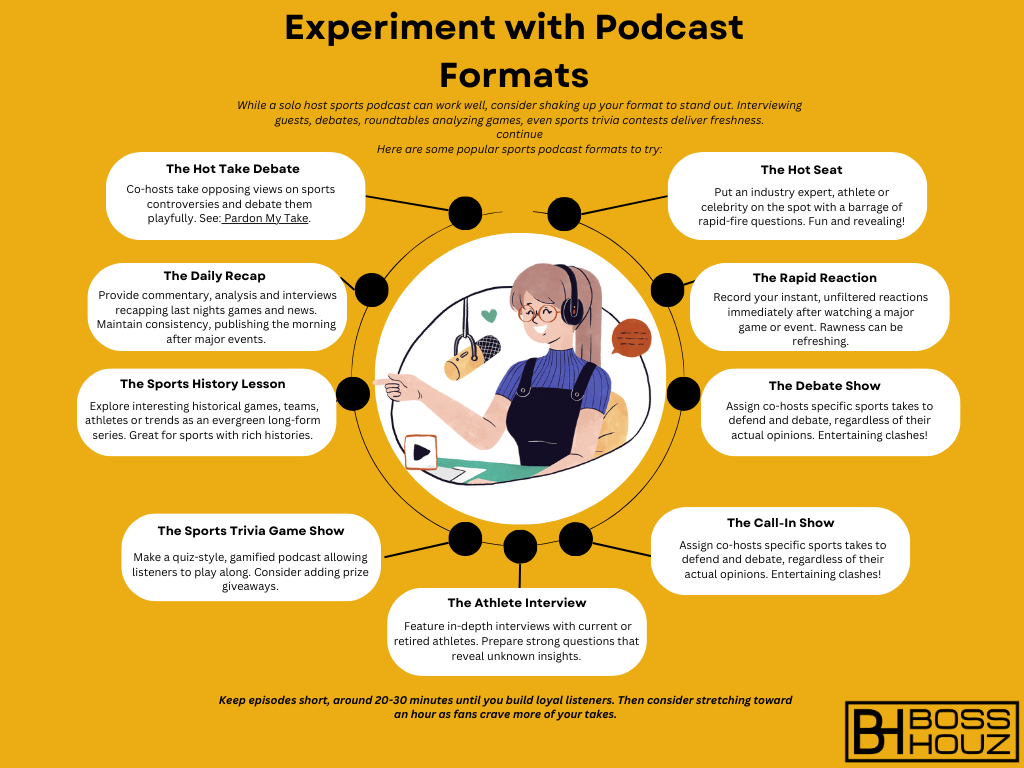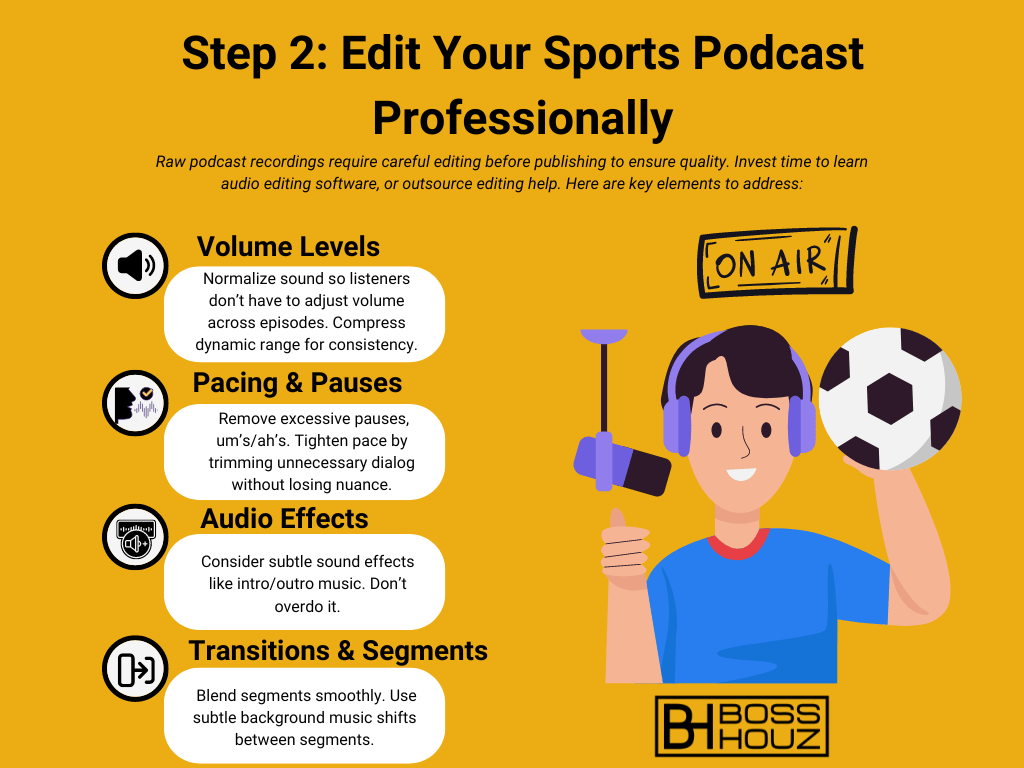So you want to start a sports podcast? Great idea! Podcasting continues to grow in popularity, with over 100 million podcast listeners in the U.S. alone. And sports podcasts are more popular than ever, as fans can’t seem to get enough sports analysis, commentary, interviews and coverage.
However, while starting a sports podcast may seem easy on the surface, there are some key dos and don’ts you need to consider if you want to create a successful show. Get these right, and you’ll be well on your way to building an audience and potentially even earning revenue from your production. Miss the mark, and you may fizzle out fast.
In this breakdown, we’ll give you the inside scoop on launching a sports podcast, from crucial steps for planning your content format to secrets for scoring sponsorships. Follow our tips to produce professional-grade episodes that engage listeners across platforms. Most importantly, remember that quality original audio content is vital for standing out in the crowded podcast universe.
Let’s jump right in to the essential dos and don’ts for sports podcasting success!
Table of Contents
Choose a Specific Niche and Target Audience
One of the biggest mistakes new sports podcasters make is failing to focus their show. With so many podcast genres and subjects to choose from, it helps to have a very specific niche to dominate.
Ask yourself:
- What unique perspective can I offer in the sports podcast arena? Avoid hot take debates unless you have insider expertise. Provide in-depth analysis on niche topics instead.
- What is my unique voice and personality I can showcase? Authenticity connects with audiences.
- Who is my target listener and what do they want? Tailor your content accordingly. Strike a balance between entertaining novices and providing depth for diehard fans.
Envision your ideal listener. Get specific on the sports, teams, leagues or aspects you’ll cover. This clarity makes promoting your pod to that audience much easier down the road.
Avoid insider jokes and assume listeners are new to your podcast. Give context before referencing obscure history or commentary the average fan wouldn’t know.
Set Realistic Expectations on Time Commitment
Creating excellent sports podcast content is a labor of love—and time. Between planning episodes, recording, editing, publishing and promoting, expect to invest at least 5-10 hours per week.
Give yourself at least 2-3 months to plan solid show formats, line up special guests, nail your audio editing process and promote ahead of launch. Rushing into publishing too fast can hurt quality.
Top tip: Schedule episodes and release dates in advance using a podcast content calendar. This ensures you generate consistent content on time.
Experiment with Podcast Formats


While a solo host sports podcast can work well, consider shaking up your format to stand out. Interviewing guests, debates, roundtables analyzing games, even sports trivia contests deliver freshness.
continue
Here are some popular sports podcast formats to try:
The Hot Take Debate: Co-hosts take opposing views on sports controversies and debate them playfully. See: Pardon My Take.
The Daily Recap: Provide commentary, analysis and interviews recapping last nights games and news. Maintain consistency, publishing the morning after major events.
The Sports History Lesson: Explore interesting historical games, teams, athletes or trends as an evergreen long-form series. Great for sports with rich histories.
The Sports Trivia Game Show: Make a quiz-style, gamified podcast allowing listeners to play along. Consider adding prize giveaways.
The Athlete Interview: Feature in-depth interviews with current or retired athletes. Prepare strong questions that reveal unknown insights.
The Hot Seat: Put an industry expert, athlete or celebrity on the spot with a barrage of rapid-fire questions. Fun and revealing!
The Rapid Reaction: Record your instant, unfiltered reactions immediately after watching a major game or event. Rawness can be refreshing.
The Debate Show: Assign co-hosts specific sports takes to defend and debate, regardless of their actual opinions. Entertaining clashes!
The Call-In Show: Enable listeners to call a hotline to give reactions, takes, comments or questions live on air. Great fan engagement!
Keep episodes short, around 20-30 minutes until you build loyal listeners. Then consider stretching toward an hour as fans crave more of your takes.
Define Your Monetization Plan
Let’s shift gears to discuss the business side of podcasting. How will you profit from your passion project while retaining integrity?
If growing your personal brand or business is the goal, that’s perfectly valid too! But most podcasters desire at least modest income after investing major time into content, so monetization models matter.
Common options include:
- Paid Subscriptions – For example, Patreon allows setting subscriber tiers granting access to bonus episodes or content.
- Sponsorships – Negotiate custom ad integrations or dedicated segments promoting brands. Vet sponsors carefully for good alignment.
- Affiliate Marketing – Earn commissions promoting relevant products through special links. Ensure transparency with listeners.
- Merchandising – Sell show t-shirts, mugs, hats or other swag featuring your brand.
- Live Events – Host special meetups, talks, or pub trivia related to your show. Charge access fees.
Give away your podcast free at first while building an audience large enough to implement paid channels. Be extremely selective on sponsors to avoid compromising quality over quick commercial dollars.
Let’s now tackle the step-by-step process for creating a sports podcast.
Step 1: Source Equipment for Recording Sports Podcasts
High-quality recording equipment is non-negotiable for pleasing sound. Budget $200-$500 for starter gear:
Microphone
– A dynamic USB mic built for podcasting captures the best audio. The classic Blue Yeti runs under $150.
Audio Interface
– This connects your mic to the computer, often improving sound. The Focusrite Scarlett series offers an affordable option.
Headphones
– Invest in studio-quality headphones like the Sony MDR7506 so you can monitor sound closely.
Mic Accessories
– Consider a pop filter for crisper recording and mic stand for proper positioning.
Here are some additional equipment recommendations:
Recording Software
– Audacity offers a free, open-source audio recording platform. Garageband works seamlessly for Mac users.
Audio Editing Software
– While Audacity and Garageband allow editing, advanced options like Adobe Audition may be worth the monthly fee.
Acoustic Treatment
– Sound dampening panels prevent echoes for professional studio sound. DIY solutions like foam work temporarily.
Portable Recorder
– Capture interviews anywhere using a handy device like the Zoom H5 Handy.
Focus spending on the essentials first, then upgrade equipment over time as your audience grows. Set up your recording space properly as well – an enclosed room with sound dampening materials is ideal.
Pay attention to sound editing too for crisp finished products. Now let’s explore podcast editing and distribution best practices.
Step 2: Edit Your Sports Podcast Professionally


Raw podcast recordings require careful editing before publishing to ensure quality. Invest time to learn audio editing software, or outsource editing help. Here are key elements to address:
Volume Levels
Normalize sound so listeners don’t have to adjust volume across episodes. Compress dynamic range for consistency.
Pacing & Pauses
Remove excessive pauses, um’s/ah’s. Tighten pace by trimming unnecessary dialog without losing nuance.
Audio Effects
Consider subtle sound effects like intro/outro music. Don’t overdo it.
Transitions & Segments
Blend segments smoothly. Use subtle background music shifts between segments.
Once edited, export your podcast episodes into MP3 files. Create cover artwork reflecting your brand. Then submit your podcast feed to directories like Apple Podcasts and Spotify for distribution across platforms.
Step 3: Grow Your Sports Podcast Audience
With production covered, let’s explore proven promotional strategies to attract listeners.
Leverage Social Media
Promote new episodes across your social profiles. Interact with listeners and consider paid ads to expand reach.
Pitch Guest Appearances
Reaching out to aligned podcasters for cross-promotions or guest spots expands your audience.
Optimize SEO
Include keywords in titles, descriptions and shownotes. Transcribe podcasts for text SEO too.
Build Email Lists
Offer opt-in bonuses for subscribing. Send new episode alerts and special offers.
Run Contests or Giveaways
Encourage shares via social for prize entries. Gain emails for future outreach.
Analyze Metrics
Study listener, download and engagement stats to refine strategies. Find out what content resonates most.
Rome wasn’t built in a day, so patience pays off. But applying these proven tactics diligently positions you for podcasting success.
For even more guidance, let’s run through answers to the most frequently asked questions from new sports podcasters.
FAQs: Key Considerations for Starting a Sports Podcast
What equipment do I need to start a sports podcast?
Focus your starter budget on a USB
continue
Here are the key pieces of equipment needed:
- USB microphone ($100-$150)
- Microphone stand ($10-$20)
- Pop filter ($10-$20)
- Studio headphones ($50-$150)
- Audio interface ($100-$200, optional but recommended)
- Recording/editing software (free options like Audacity or Garageband for Mac)
Ideally also set up your recording space with sound dampening acoustic treatment. Invest in upgrades over time as your audience grows.
How much does it cost to start a sports podcast?
You can launch a podcast for less than $500 in most cases. The largest expenses are recording equipment ($250-500) and optional paid promotion once you begin publishing episodes.
Ongoing costs add up in web hosting ($5-$20/month), media hosting (free to $20/month), and software subscriptions. Consider Patreon to offset costs through fan subscriptions.
How long should a sports podcast episode be?
For a new show, aim for 20-35 minute episode length. Shorter formats respect listeners’ time early on when you’re building an audience.
Once established with loyal followers craving more content, consider stretching toward 60 minute lengths. Analyze listener drop-off rates to guide ideal timing.
How often should I release new episodes?
Release once a week at first, on a consistent schedule like new episodes every Monday. This gives you time to produce quality content while training fans to anticipate and engage with each episode.
As you scale production capacity, increase to 2-3 times per week. Daily shows are intense even for veterans, so pace yourself starting out.
Where can I host my sports podcast?
Top podcast media hosting platforms include:
- Buzzsprout – easy set up & distribution
- Libsyn – robust metrics
- Omny Studio – sleek customization
For niche sports topics, leverage sports-centric platforms like:
Many offer free plans to start as you build audience size.
What sports should my podcast focus on?
Ideally choose 1-2 sports to start, with a specific lens like a geographic area (Boston sports), league (NBA analysis) or athletic focus (golf instruction). This targeted niche helps attract superfans seeking depth.
Expand scope over time once established, rather than jumping randomly between scattered sports topics early on. Become known as an expert voice.
Should I have a co-host for my sports podcast?
Co-hosts can provide fun banter, diverse opinions and shared workloads. Choose someone complimenting your knowledge gaps or personality style.
However, solo hosts succeed too by heavily featuring guests. Test shows with and without co-hosts to learn what resonates best with your audience.
How can I make money from my sports podcast?
Once you build an engaged following, monetize through:
- Advertising revenue shares from podcast networks
- Sponsorships aligned to your audience
- Affiliate marketing commissions
- Premium subscriber benefits and early access for paying members
- Merchandise sales featuring your brand
Ensure monetization aligns with your audience expectations. Transparency is key.


Wrapping Up Starting a Sports Podcast
We’ve run through the entire playbook for planning, launching and growing a successful sports podcast – from crucial equipment to monetization options. By focusing your sports niche, producing consistent high-quality episodes, and methodically building an audience, your show can thrive.
Remember that podcasting is an investment requiring significant time, but the personal and financial payoffs of owning a professional media platform make the effort worthwhile.
Here’s a quick recap of the key dos and don’ts covered across our guide:
DO:
- Choose a specific niche/lens: Become known as an expert voice on precise topics.
- Invest in quality equipment: Good recording gear ensures great sound to hook listeners.
- Format shows creatively: Interview guests, include call-ins, host debates – keep things fresh!
- Release episodes consistently: Train fans to know exactly when new episodes drop weekly.
- Promote across social media: Meet listeners where they’re actively engaging already.
DON’T:
continue
Here are the key don’ts:
- Don’t sell out for sponsors: Vet advertisers thoroughly and retain control over content.
- Don’t neglect editing: Tightly edited episodes have professional sound quality.
- Don’t stray from your niche: Resist bouncing sporadically between topics to build loyal followers.
- Don’t wing episode plans: Always outline segments and questions for fluid discussion.
- Don’t ignore legal aspects: Understand music licensing, liability waivers for guests, etc.
We hope this guide has equipped you with the actionable advice needed to start your sports podcast successfully. Just remember that finding your unique voice, connecting authentically with listeners, and consistently improving based on feedback matters more than anything.
The rest – securing the right equipment, optimizing workflows, even earning revenue – flows more easily when you lead with genuine passion for the game and your fans above all else.
Here’s to starting an amazing new chapter in your sports journey! Let the creative fun begin.








